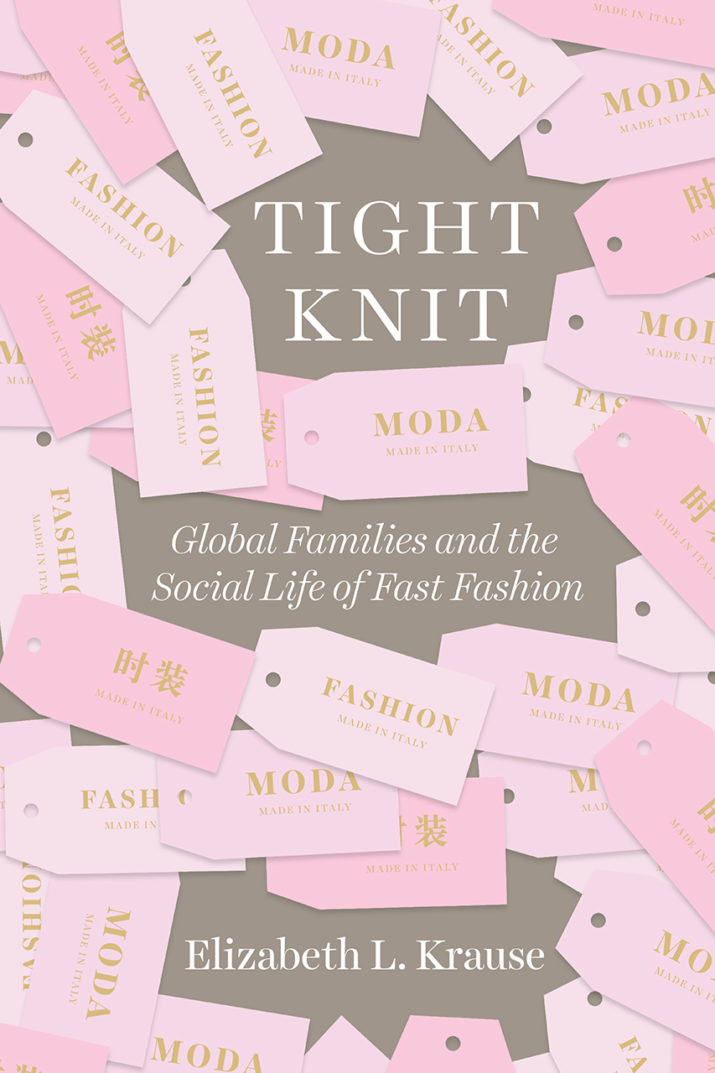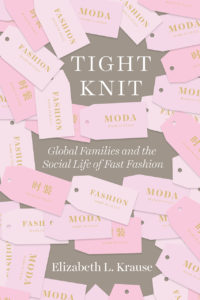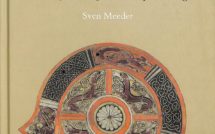
 Fast fashion has taken the world by storm in recent years, and the opportune release of Elizabeth Krause’s Tight Knit gives ethnographic depth to a growing controversy: the exploitative labor practices central to fast fashion production and the global apparel industry. Krause traces how fast fashion’s global supply chains reshape imaginings and experiences of migration, kinship, and cultural integration, forcing us to rethink common narratives of globalization. Based on years of fieldwork in Prato, Italy in the heart of Tuscany, Krause engages this region of small, interconnected family-owned workshops, once home to luxury Italian textile production and now a central node in the global supply chain of “Made in Italy” fast fashion produced by Chinese migrants, as a “laboratory of globalization” (29). Krause argues against the popular narrative of global capitalist expansion as the homogenous spread of highly industrialized factory production and this narrative’s protagonist, Homo economicus. Instead, she chooses to focus on the “crookedness” of capitalism by examining how differing experiences of history, money, kinship, and cultural belonging weave a new, complex social fabric central to apparel production (7). Tight Knit’s protagonists, the Chinese migrants who form the majority of her interlocutors, demonstrate the ways in which global supply chains depend upon kinship ties and reshape social worlds. However, while Krause successfully challenges common understandings of capitalism and globalization with her expert analysis of value-making and transnational kinship, the focus on “tight knit” relations precludes a more fruitful analysis of the current fraying of the social fabric in Italy and the world at large.
Fast fashion has taken the world by storm in recent years, and the opportune release of Elizabeth Krause’s Tight Knit gives ethnographic depth to a growing controversy: the exploitative labor practices central to fast fashion production and the global apparel industry. Krause traces how fast fashion’s global supply chains reshape imaginings and experiences of migration, kinship, and cultural integration, forcing us to rethink common narratives of globalization. Based on years of fieldwork in Prato, Italy in the heart of Tuscany, Krause engages this region of small, interconnected family-owned workshops, once home to luxury Italian textile production and now a central node in the global supply chain of “Made in Italy” fast fashion produced by Chinese migrants, as a “laboratory of globalization” (29). Krause argues against the popular narrative of global capitalist expansion as the homogenous spread of highly industrialized factory production and this narrative’s protagonist, Homo economicus. Instead, she chooses to focus on the “crookedness” of capitalism by examining how differing experiences of history, money, kinship, and cultural belonging weave a new, complex social fabric central to apparel production (7). Tight Knit’s protagonists, the Chinese migrants who form the majority of her interlocutors, demonstrate the ways in which global supply chains depend upon kinship ties and reshape social worlds. However, while Krause successfully challenges common understandings of capitalism and globalization with her expert analysis of value-making and transnational kinship, the focus on “tight knit” relations precludes a more fruitful analysis of the current fraying of the social fabric in Italy and the world at large.
In Part One, “Chinese Immigration and the Made in Italy Brand,” Krause adeptly complicates notions of capitalist value by examining sentiments, both historical and familial, as forces of production in the creation of the “Made in Italy” brand and the global fast fashion industry. Krause argues that “associations create value” by showing how the construction of historical narratives have established Italy as a modern fashion capital, connecting the country’s Renaissance past to its contemporary fashion aspirations (67). Maintaining these historical connections are key to reproducing the “Made in Italy” label as desirable and luxurious in the minds of global consumers, concealing the realities of Chinese migrant labor exploitation that undergird its production. Krause illustrates how, beyond tenuous connections to imagined luxury, the value of fast fashion lies in its ability to satiate a seemingly endless desire for the latest trends with heightened flexibility and shortened production schedules that inevitably shape the lived experiences of Chinese migrant workers. Here, the history of Prato and its small family-owned firms dedicated to apparel production meets the history of Wenzhou, the region of China from which the overwhelming majority of Pratt’s workers migrate, and the quest for money that invigorates workers’ desires to run their own firm in the context of a restructuring global apparel industry. As the “Made in Italy” brand continues to connote luxury thanks to the efforts of these migrants, Krause encourages moving beyond value as labor time by considering a fuller view of value-making activity invariably attached to place and the world making of workers.
The chapters “Money” and “Crisis” serve as the entry to Krause’s exploration of the social life of fast fashion. Krause illustrates how making families and goods go hand in hand as the drive to earn money is inextricably tied to the need and desire to support one’s family back home, as well as the families they create in Italy. Moreover, as migrants from the Wenzhou province seek to establish themselves as independent entrepreneurs in order to support familial networks, the search for money recreates the local social fabric of Prato. The workers’ focus on entrepreneurship is thus as much about creating comparative advantages in the global apparel industry as it is about establishing and maintaining transnational, or as Krause labels them, global families. Krause argues that money is used to make sense of the world insofar as the quest for money organizes workers’ lives and the social worlds they come to inhabit. Her interviews with migrants in a variety of employment and immigration situations offer evocative testimonies of how the rhythms of fast fashion production dictate the schedule and pace of the lives of workers. Often living in their cramped workspace, daily life throughout the year is determined by the availability of work and the shortness of expected turnaround as they attempt to formalize their citizenship and become business owners, simultaneously navigating a global industry, uncertain immigration status, and uneasy cultural belonging. Thanks to the length of Krause’s fieldwork, she is also able to cover the before and after of the financial crisis of 2008 through poignant stories of economic survival, as the crisis exacerbated the tensions between a changing global industry reliant on increasing labor flexibility, migrants’ need to make money, and the rising antagonism around immigration and citizenship.
Perhaps the greatest strength of Tight Knit lies in Krause’s analysis of “Circuits of Care” in Part Two. Examining the circulation of Chinese migrants’ children between family members in Wenzhou and their working parents, Krause illustrates how global supply chains depend upon and (re)produce chains of migration shaped by kinship networks as migrants follow familiar networks to participate in transnational production processes in the hopes of providing for themselves and relatives. Many Chinese migrants choose to send their children to Wenzhou to be raised by family members due to busy schedules and a strong desire to maintain relations of reciprocity with kin, often disrupting the child’s Italian education. These circuits present challenges both for migrant parents navigating economic uncertainty and for the Italian state attempting to register and educate a growing number of migrant workers’ children. Krause illustrates how the question of whether or not a child will remain in Italy exposes the ways in which nationality, different cultural understandings, and belonging are negotiated in encounters of unequal power between migrants and Italian professionals. Coining the term “encounter ethnography,” Krause argues that “jarring epistemological moments” occur in the interaction between expert and lay knowledge that can be fruitfully analyzed, as when she skillfully employs ethnographic research to delineate how regular interactions, like routine postnatal check ups, can reinforce cultural misunderstandings, stereotypes, and dominant cultural positions (17). By highlighting the imbalances in power that shape everyday interactions, from those between the ethnographer and her informants to those between Chinese migrants and Italian institutions and state bureaucracy, Krause exposes the role these unequal negotiations play in mediating global forces and remaking migrants’ social world.
We come to fully appreciate the title of this monograph, Tight Knit, as Krause further examines the remaking of social life in Prato in Part Three, “The New Politics of Urban Racism.” Krause employs social events, conferences, and political debates to analyze how cultural belonging and integration are imagined by officials, citizens, and migrants. Exposing the one-sided nature of integration as imagined by conservative Italian politicians who emphasize knowing Italian language and history, Krause argues that racism has been refigured from biological to cultural incommensurability. This incompatibility, Krause contends, is belied by the similarities of social position and experience between previous generations of southern Italian textile workers and contemporary Chinese migrants. Just as Italians from the south came to work for low wages in precarious conditions while relying on familial networks in the 1970s and 80s, the Chinese are doing much the same today, while also experiencing similar discrimination. This overlooked sameness and shared humanity allows Krause to conclude that Prato’s social relations “reveal a tight-knit, yet at times fraught, weave” (244). This, however, rings hollow considering her own admissions, made multiple times throughout the book and shown in interactions with interlocutors, of the pervasiveness of overtly racist sentiments. Consequently, the final part of the book is unfortunately a missed opportunity to speak about the everyday people with whom we have routine interactions whose beliefs also tacitly, or not so tacitly, give consent to a growing rise in far-right extremism. Given current events in Italy and abroad, the concluding argument that continued co-presence augurs wells for sociality and mixité falls a bit flat when a more stringent push-back on her more conservative Italian interlocutors would have proven prescient. As it stands, the end serves as a warning against the common temptation of ethnographers to place hope in the complexity of the social fabric to engender fellow feeling when the global moment calls for a better and deeper understanding of the rise of right-wing conservatism.
Ultimately, Krause offers a compelling and necessary contribution to the theorizing and understanding of capitalist globalization, the fast fashion industry, and the global supply chains remaking the local social fabric worldwide. Tight Knit undeniably holds valuable insights for multiple audiences. For anthropologists, this ethnography does the much needed work of validating fashion production and consumption as serious topics for social analysis and ethnographic research. Tight Knit will also prove useful to students and academics in various disciplines thinking through questions of globalization, migration, and labor. Finally, the humanizing portrait Krause paints of the Chinese migrants in Prato holds value for the general public interested to learn more about the lives and work of the families responsible for their fast fashion favorites.
Reviewed by Elandre Dedrick, Stanford University
Tight Knit: Global Families and the Social Life of Fast Fashion
By Elizabeth Krause
Publisher: University of Chicago Press
Hardcover / 304 pages / 2018
ISBN: 9780226557915
To read more book reviews click here
Published on December 11, 2018.




